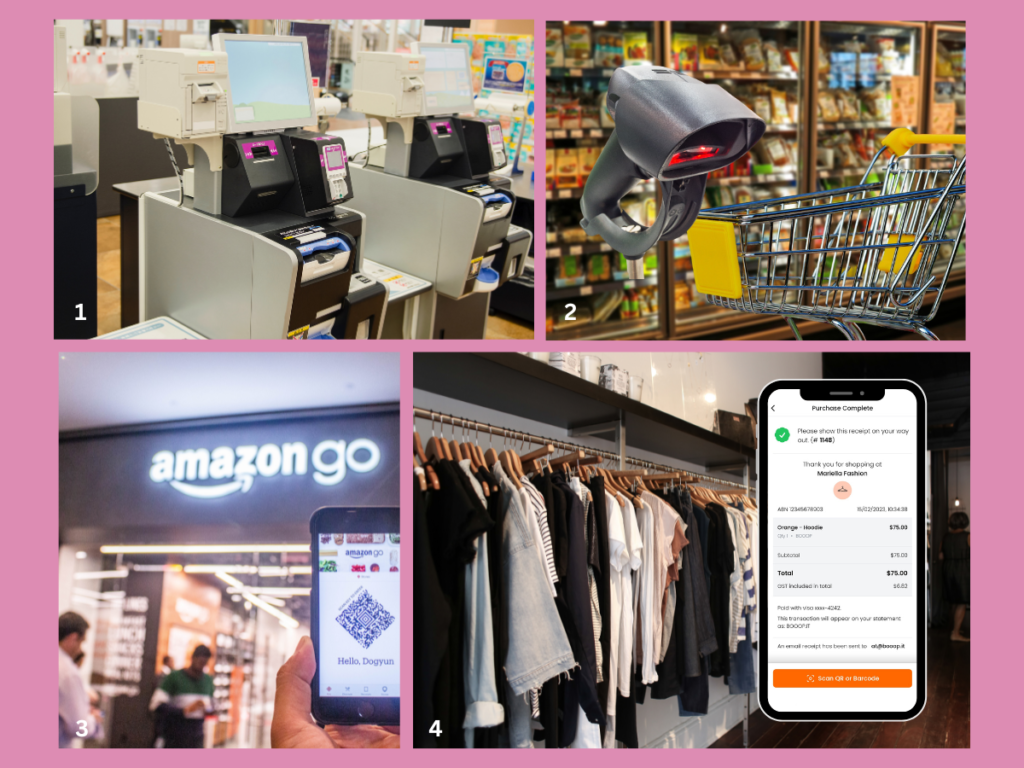Retail checkout trends
Customer experience is fundamental to the retail checkout process. There has been a dramatic shift in consumer behaviour since the pandemic, and retailers are having to adapt quickly to meet customer expectations in order to succeed and remain relevant. As a result of this we have seen large retailers invest heavily in customer experiential shopping instore, with multiple check-out options provided to shoppers.
Queue busting technology and providing a seamless shopping experience
Whether you love it or hate it, self-checkout has been around for decades and is on the rise and taking many new and innovative forms.
Self-checkout highlights how technology has transformed the payment process for instore shopping. This technology has been accelerated by the global pandemic and the desire for contactless purchasing. ResearchAndMarkets.com forecasts that in this changed landscape the global market for self-checkout systems estimated at US$3.7 billion in the year 2022 is projected to reach US$9.3 billion by 2030, a significant increase in investment by retailers.
Self-checkout systems
There are a multitude of options for self service checkouts, that enable customers to checkout without an assistant. They all come with their pros and cons for both the retailer and the customer. Types of self-checkout systems include:
1. Express self-checkout counters and kiosk systems or grab and scan
2. Mobile scanners and carts
3. Self-checkout sensors and AI
4. Mobile scan and go self checkout app.

As retailers invest in self-checkout technologies from the very familiar self-checkout kiosks, which enables customers to scan items and checkout themselves, through to sophisticated autonomous checkout systems, which use computer vision technology allowing shoppers to walk in and walk out completely cashierless.
But some of the leading innovations in self-checkout technology are not simply about offering customers’ an alternative payment system, they are so much more…

So what are the current trends and who are some of the leading innovators?
Amazon
- Amazon Style – This is a physical clothing store with touchscreens and QR codes. Using the Amazon Shopping app customers can scan QR codes to see more details, including sizes, colours, and customer ratings of the products. Customers can scan an item and only need to pick it up at the end of their browsing. They can also send items they like to a fitting room.
- Amazon Go – These convenience stores have been opening in the US and the UK (where it’s known as Amazon Fresh). Using the Amazon app, when you walk into the store, you pick out what you want (no scanning) and simply walk out when you’re done. The app charges you for the products you have picked out as you leave the store. Amazon calls it: “Just walk out technology”.
Amazon Go is experimenting with these stores to find the right format and one that differentiates from competitors and appeals to the customer. It has recently reported the closure of some of these stores, highlighting the complexity of balancing technology and the retail experience.
Nike
The Nike App is designed to connect the world of tech with instore physical retail, transforming the customer’s phone into their ultimate shopping companion. The app enhances the shopping experience offering triggered rewards, unlocking access to exclusive promotions or special offers and Nike Scan, while browsing in the store you scan barcodes and unlock information about these items. Customers receive product recommendations based on what they love, plus fast and secure checkout.
When they launched the 68,000 feet Nike House of Innovation store on Fifth Avenue, New York, it was designed to be as personal and responsive as a digital experience but immersive and with a human connection. This store and other HOI locations including Shanghai and Paris, work with the Nike App to offer even more choices through your phone.
Mr Yum
Melbourne based mobile food ordering and payments platform. After scanning a QR code on their table, customers are able browse through the visually pleasing menu, see a description of the dish and order from their phones. This eliminates administrative tasks such as writing orders down, processing payments and splitting bills.
As of April 2023, Mr Yum venues have seen a spend per head increase by 33%, acquire 3x guest data, and benefit from 41% more return visits. The power of a simple ‘scan’ unlocks a new customer experience, which has provided restaurant owners with a new form of engagement with their customers.

As a retailer what type of payment checkouts should you invest in?
With consumer mobile usage behaviour changing, mobile-checkout is transforming the physical in-store shopping experience. Mobile check-out promotes more personalised customer in-store interactions while reducing the mundane administrative tasks like payments processing, checking for stock availability, or providing product information. The uptake of new technology in the retail industry is continually gaining traction and in particular mobile-checkout is on the rise, this in part is due to its availability and accessibility to both the consumer and the retailer.
Finding the right checkout system will differ for each individual retailer, the type of store, the size of the company, your customer base and so on. One size definitely does not fit all!
For the retail giants like Amazon, investing in AI and innovative tech might be possible, however, for the vast majority this is simply unrealistic. Labour shortages, hiring the right people, and retaining staff is yet another challenge that retailers face.
Adopting technology while still offering customers that personal in-store experience is a complex balance. Changing any system and adapting your business can feel overwhelming. Mobile checkout can offer retailers a flexible and more affordable option compared to other payment systems—enabling retailers to provide their customers with alternative checkout payment services while maintaining that human connection and keeping up with industry trends.
About Booop
In-store shopping has never been more fun and convenient. For retailers Booop merges physical retail with a digital presence, shoppers can now discover product information, checkout, and pay for products — all from the convenience of a mobile phone. No more lines at checkout!
Our mission is to create the most seamless and cost effective tool to manage both physical and online stores, freeing up time for retailers and helping them thrive.
Here at Booop, we believe simplicity is key – a world where multiple software products, additional terminals, and extra hardware are no longer required. We strive to create simple, well-designed software that does what it needs to do, and leaves new and growing businesses with more time to connect with their customers.
For shoppers, we want to make the retail experience better: contactless checkout, self-service, and more information available in-store so shoppers can make decisions based on what matters to them most.
We’re at the beginning of our journey, and we’d love to have you along for the ride! Find out more at Booop contact